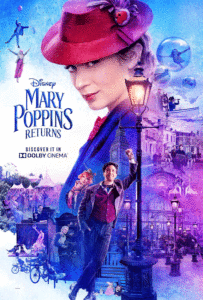Movie Review: Mary Poppins
By Mahnoor M. Farooqui | Movies | Published 6 years ago
 As soon as the orchestra swells up with a rendition of the classic and memorable soundtrack of Mary Poppins in the opening credits, it truly feels as though the vivacious and well-turned out nanny has returned. Set several decades after the original 1964 film, and during the time of the Great Depression – or the ‘Great Slump,’ as it is referred to in the film – the movie follows Jane and Michael Banks, all grown up, with their own set of grown-up problems.
As soon as the orchestra swells up with a rendition of the classic and memorable soundtrack of Mary Poppins in the opening credits, it truly feels as though the vivacious and well-turned out nanny has returned. Set several decades after the original 1964 film, and during the time of the Great Depression – or the ‘Great Slump,’ as it is referred to in the film – the movie follows Jane and Michael Banks, all grown up, with their own set of grown-up problems.
Michael (Ben Winshaw) is a widower struggling to keep his house from being repossessed. His three precocious children, Annabel, John and George (Pixie Davies, Nathanael Saleh and Joel Dawson), and his sister Jane (Emily Mortimer) are all helping to keep the house running, while Michael has taken on the job of a bank-teller at his father’s old bank, to repay the loans he took against his house for his late wife’s medical treatment.
Mary Poppins might not have made an appearance at all, were it not for the fact that the children have taken on all the household responsibilities, acting as the sole anchors of the family and forgoing the joys and adventures of childhood.
What could have been a dismal mantle cast over the movie, is instead precisely what sets the second instalment apart from the original feature. Mary Poppins Returns handles grief and larger-than-life problems the way Mary Poppins does – with sensitivity and no mawkish sentimentality.
Emily Blunt’s Mary Poppins is a strict disciplinarian with a twinkle in her eyes, who sets about giving the children structure with fun in her wry, brisk fashion. While she is no Julie Andrews, whose natural primness could snap back to form immediately after the final chords of an ebullient musical number, Emily Blunt has made Mary Poppins her own while maintaining P.L. Travers’s original concept of keeping children from growing up too fast.
The story follows the children as they try to save their home from the antagonist William Weatherall Wilkins (Colin Firth), the acting chairman of the bank who profits off defaults on house loans during the Great Slump. Then there’s the blossoming romance between Jane and lamplighter Jack (Lin-Manuel Miranda), and a new Bert complete with a Cockney accent.
Other notable additions are Mary Poppins’ eclectic cousin Topsy (Meryl Streep), the ever troubled househelp Ellen (Julie Walters), Dick Van Dyke as Mr Dawes Jr, the chairman of the bank, and Angela Lansbury as a balloon-seller. In fact, the movie is chock-full of great performances by consummate actors.
The film also features a 2D animated action sequence – much like the original with equally striking cartoons – the cheery ‘Can You Imagine That?,’ a brilliantly blue and nautical number featuring oceanic creatures who give the children company as they take a bath, and ‘Trip a Little Light Fantastic,’ an energetic take on ‘Chim Chim Cheree’ from the perspective of lamplighters – or ‘leeries,’ as they are called. Though none of the classic songs made a reentry on the new soundtrack, they were deconstructed for the orchestral score. However, the songs in the new version are vibrant and captivate the audiences as the characters sashay to the music.
While Mary Poppins Returns may score a few notches below the original that stands out as an incomparable classic, its heart is in the right place. It is sunny and leaves one feeling deliriously happy – it almost feels like Mary Poppins paid you a little visit.


